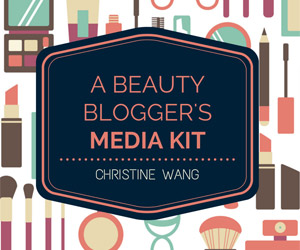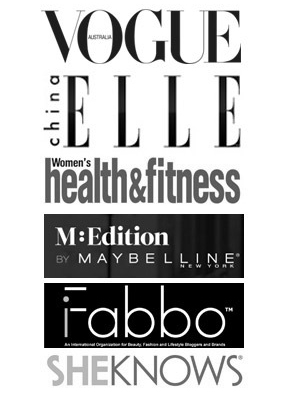
After talking about sponsored posts last week, I thought I’d carry on with another related topic to making a bit of moolah for your blog, and that is affiliate marketing. Affiliate marketing/advertising isn’t everyone’s cup of tea, so if this isn’t something you’re interested in doing for your blog, please feel free to skip today’s Bloggie Wednesday post (although I do hope you stay on and read for fun :)).
What is affiliate marketing/advertising?
So, what is this affiliate marketing? According to Wikipedia,
Affiliate marketing is a type of performance-based marketing in which a business rewards one or more affiliates for each visitor or customer brought about by the affiliate’s own marketing efforts. The industry has four core players: the merchant (also known as ‘retailer’ or ‘brand’), the network (that contains offers for the affiliate to choose from and also takes care of the payments), the publisher (also known as ‘the affiliate’), and the customer.
In other words or blogging terms, if you place an affiliate link to a product on your blog, a reader clicks on that link and buys something from retailer X, retailer X will pay you a small commission for referring your reader to them. For some affiliate networks, they will still pay you for referring the reader to retailers without the reader having to buy anything.
Next to sponsored posts, bloggers can also use affiliate marketing to draw a bit of income to the blog. This may or may not work for your blog as it depends on your niche and what your main content is about. Tech bloggers or bloggers who write about expensive high-end goods may end up making more money out of affiliate ads on their blog as the items mentioned would usually be more expensive. The higher the price, the higher the commission (e.g. cameras or designer goods).
On the other hand, these are not goods that people would purchase regularly so it might work out that the large commission isn’t consistent across the board. This really depends on how you “sell” the product.
What I like about affiliate advertising
There are a few things I like and dislike about affiliate marketing. Let’s talk about what I like about it. For instance, I’m reviewing a BB cream that I really like and highly recommend that you give it a go. The link to the retailer where you can purchase the BB cream happens to be an affiliate one. As a reader, you might want to try that BB cream out, decide to click on the link and end up purchasing the BB cream. For my efforts in referring you to them on that BB cream, I get a dollar or two from the merchant :). For a blogger, every dollar and cent helps to maintain the blog (webhosting fees, etc). Affiliate marketing is a way to earn that extra dollar and cent.
What I dislike about affiliate advertising
On the other hand, I know of bloggers who abuse affiliate marketing. Every single link on the blog becomes an affiliate link. It doesn’t matter whether the product is good or not. The financial motivation is there to just sell, sell and sell. Some don’t even disclose that the links are affiliated ones. I’ve seen a lot of RewardStyle links masked in bit.ly form and that’s not right. They can argue that they’re monitoring the progress of their affiliate links through bit.ly but really, there are other ways to do it. When you mask links, the readers can’t tell whether they’re affiliate links or not.
It doesn’t hurt to let your readers know that you’ve inserted some affiliate links in the post. The transparency of letting them know that by purchasing something via those links at no extra cost to them to help support the site shows that you’re an ethical blogger. Chances are, your readers will want to support you even more.

If affiliate advertising is something you’d like to try out for your blog, there are many affiliate advertising networks out there, e.g. RewardStyle, ShopSense, Rakuten LinkShare, ClixGalore, Amazon Associates, etc. I tried LinkShare and ClixGalore for a year but they didn’t work for me. I had a whole lot of unsightly ads on the blog’s sidebar in hopes that someone would buy something but with no luck. To be fair, although a large percentage of hits on my blog are from the US by search engine, a lot of my readers are from Australia and Malaysia. In hindsight, the affiliate ads that I placed on the blog were irrelevant to them.
Experiment with different affiliate networks
Having said that, it doesn’t mean that they will not purchase anything via those affiliate links, which is why I recommend experimenting with affiliate ads/network that you’re signed on to. Give your blog a time frame and how long you’d want to give the ad a go. Monitor its progress for a few months. If in at least 3 months you don’t get any returns, I’d say move on to something else because it doesn’t look like it’s working for you.
I once had a Strawberrynet ad on the sidebar with an affiliate link for over close to 2 years but did not get a single commission out of it. I even had affiliate links in posts (this was years ago) that yielded no results. In the end, I felt like I was advertising for them for free, which was why I removed the ad off the blog. Your blog is Internet real estate and is worth a lot more money than heaps of affiliate ads on your sidebar that isn’t earning you anything.
Affiliate networks I use on the blog
Here are 2 primary affiliate advertising networks I use on my blog.
- Revenue Sharing (Cost Per Sale)
- When readers click on your link and buy something, you get a percentage of the sales.
- The percentage of commission you get depends on the merchant. Certain merchants pay more, some pay less.
- Widely used by fashion, lifestyle and beauty bloggers (this includes merchants like Net-a-Porter, Shopbop and even Sephora)
- Very easy to use and has a useful analytics tool to check your affiliate link stats.
- Membership by application of interest only. If you’d like me to refer you, let me know! Apparently, I’ll get to earn referral commissions for a year if I refer anyone. I don’t know how this works; I’ve not made a cent out of this referral thing yet. 😛
- Cost Per Click (Pay Per Click)
- When readers click on your link, regardless of whether they buy something, you’ll get a few cents per click.
- Just like RewardStyle, this includes a wide variety of fashion, homeware and beauty retailers.
- Also has an analytics took to check your affiliate link stats.
- Free membership.
I’m still experimenting with RewardStyle and ShopSense but I do like to mix links from these 2 networks to see which one works better. While I don’t make a lot of money from these affiliate networks, I get a few dollars here and there each month. Like Google Adsense, the commission may be very small but it’s quite consistent. I make enough each year to cover my webhosting and domain fees, and that’s plenty good enough for me. 🙂
As always, let your readers know if you’ve inserted affiliate links to your post. They might like to help support your website by purchasing something via those affiliate links. Once, I wanted to buy a book from Book Depository. I asked Twitter if anyone is affiliated to Book Depository so that I can buy the book off their affiliate link. There’s no extra charge for me but that person made some money out of it albeit a tiny sum. But hey, it’s still money, right? 🙂
Have fun experimenting with affiliate ads and let me know how it works for you!
Are you with any affiliate networks? What works best for you?













Great article Tine, as always! It absolutely kills me when I see people NOT disclosing affiliate links, or hiding them under the bit.ly banner. It makes me start distrusting the blogger as if you’re hiding your affiliate links, what else are you lying about? That said, I’ve just started experimenting with affiliate links myself and let’s just say it’s not enough to get me to leave my day job! I’m trying Zanox.com which seems ok, though their user interface is so confusing it’s doing my head in!
Lilit recently posted..And the answer is….
Thanks Lilit. The link-masking came to a point where Pinterest banned all masked RewardStyle links (a lot of people were masking the links with bit.ly). I don’t think there’s anything wrong with using affiliate links as long as you disclose what they are. Why hide them, right?
I make a few dollars here and there a month. When accumulated, it should hopefully cover my Feedblitz fees. As long as a bit of money earned here and there can cover all the blogging fees, I’m happy enough.
I’ve not used Zanox.com before, thanks for the link. 🙂
I love Bloggie Wedn., and I’ve learned quite a lot from it. Thanks Tine for always sharing with us great tips and information. I do link to various retailers in my blog posts, but they are not affiliate links. Just there for convenience in case if readers would like to click for more product information. I’ll definitely take note of this article. Running a blog costs money, and I’ll probably need some financial help down the road.
Angela @ The Unprofessional Beauty Blog recently posted..Level Naturals Shower Bomb|Spa Aromatherapy Right In My Bathtub
Thanks Angela. You can check where your readers are mostly from on Google Analytics. If they’re mostly from the US, it’s worthwhile putting in affiliate links of US merchants. Back in the day, I mostly had Malaysian readers and putting up US merchants’ affiliate links didn’t work at all because 1) most of my readers weren’t from the US and 2) online shopping wasn’t very big back then.
Now that online retailers have grown so much and people are shopping online more, I think affiliate links do help. It may not be enough to pay your bills but every little bit helps to keep up with the costs of running your blog. Good luck!
Great post! I agree that blogs that pepper their posts with affiliate links make it hard for me to trust them. I really appreciate it when blogs are upfront and say that there are affiliate links in the post, but their opinions are still honest. That would actually make me more likely to use their affiliate link as a thank you for referring me to a great product, rather than a blog’s that I feel is just trying to sell me stuff.
My sentiments exactly, Rose. I’d very much prefer to buy something off an affiliate link from an honest blogger than from one that’s just out to sell, sell, sell.
As always, love the bloggie wednesdays 🙂
I think it’s a good idea, you never know what you might make. I havent seen many bloggers who can quit their day job and earn income from their site (if only!), but it doesn’t hurt to try right? I’m all for bloggers supporting their site to cover costs.
I agree that they should disclose though, before I read blogs I had no idea about affiliate links and if it wasnt for honest bloggers disclosing I would never have known. I’ve read a long forum thread before on how much readers dislike it. It’s better to just be upfront 🙂
Kaye recently posted..Free Bloglovin’ Illustrated & Animated Icons
Hehe thanks Kaye 🙂
I think for beauty bloggers, making money from affiliate links alone won’t be enough for one to quit her day job. Beauty products on the whole aren’t very expensive and while it’s very nice to earn a dollar here and there, it’s definitely not enough to go full-time on that alone. Having said that, the amount made from affiliate advertising may not be enough to pay the rent but accumulatively should be enough to say, pay for a year’s webhosting fees. For me, that’s one side of out-of-pocket costs saved and I’m happy about it 🙂
Great post, as always! I have been experimenting with affiliate networks for years and the only two that have worked for me and that I still use are commission junction and skimlinks. I use CJ banners in my sidebar and make about 2 or 3 euros every month. It’s not much, but it helps to pay blogging costs. It’s the strawberry.net and elf banners that perform the best for my site.
Instead, I use Skimlinks to add affiliate links to my posts. You just have to add a code to your blog template and it automatically turns normal links into affiliate links. You have access to thousands of affiliate programmes from different networks, and you don’t have to be approved for them, which makes it very convenient to use. The downside is that you can’t choose which links to turn into affiliate ones so I may end up making money from a product I like only so-so if I link to a site where it can be purchased (if I really hate the product, I usually mention only the site, without adding a link). But because I always point out the pros and cons of a product in my reviews, and always disclose affiliate links anyway (it really irritates me when bloggers don’t), this doesn’t bother me much. After all, my readers know what they’re getting if they decide to buy it anyway, and most of them simply wouldn’t. The important thing is simply to be honest about it.
gio recently posted..Product Review: Labrosan Soothing Lip Balm
Thanks Gio. Don’t know why, but the Strawberrynet links don’t work for me, which is why I had to take it down.
I’ve heard a lot about Skimlinks. I couldn’t use Skimlinks with Shopbop (at least, not until after August) because they’re currently advertising on my site so Skimlinks for Shopbop aren’t allowed. Thanks for the recommendation though; I’ll check it out and see if it works for me 🙂
I agree. Nothing wrong with using affiliate links as long as it’s disclosed.